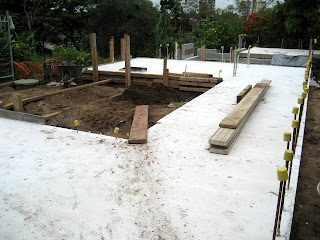 The light-coloured (and light-reflecting) concrete was poured last week for the Dining Room, Gallery, Study and Laundry. This pale colour comes at a financial cost so the lower part of the pour (footings) used grey Portland cement.
The light-coloured (and light-reflecting) concrete was poured last week for the Dining Room, Gallery, Study and Laundry. This pale colour comes at a financial cost so the lower part of the pour (footings) used grey Portland cement. 
Both concrete mixes contained recycled elements to improve properties and reduce embodied energy.






4 comments:
What benefits are available for such a thick concrete slab? Won't the fact that it's directly in contact with the earth mean that a thinner concrete slab would have the same amount of thermal mass below it compared to a thick slab (the heat will spread into the slab and surrounding earth as far as it reaches and both concrete and earth have a high thermal mass), but a thinner slab would be much cheaper to build?
R+
Hi there R+
The image you see is the slab and the footing edge (darker). The substrate is loose alluvial silt and the slab is as thin as the structural engineer would allow, with decent footings to compensate for the unstable soil. Slab thicknesses vary from 100-125mm for slab-on-ground and 170mm for suspended slabs.
Concrete is a environmental conflict in sustainable design with its high embodied energy. We have chosen it for some places because of it's great thermal mass properties, longevity and structural properties.
We have tried to minimise concrete volume and wherever possible/available/permissible, incorporated recycled content in reinforcing steel and cement mix. All concrete slabs will be exposed and polished (not carpeted, covered with timber or tiles) removing any potential additional embodied energy.
Thermal mass is directly related to the thickness of the concrete slab. In summer, slab on ground helps to absorb the heat and provide walking comfort. In winter, slab on ground receives sunlight during day time and release the heat at night. House orintation shall be design to make sure that the slab does not get direct sunlight during summer but does so in winter
We have concrete precisely for the reasons you mentioned in your comments and in the ways you mentioned with sunshading in summer and exposure in winter. We provided thermal mass to stabilise temperatures but were efficient in its use due to the high embodied energy of concrete (even though we lowered that with use of fly ash and reactive magnesium)
Post a Comment